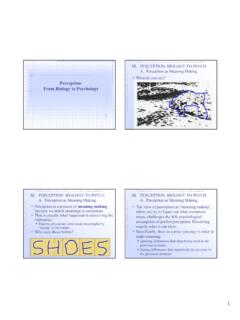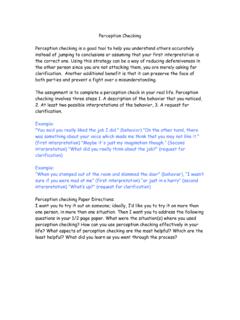Transcription of Intra Personal Processes UNIT 5 PERCEPTION
1 Intra Personal Processes unit 5 PERCEPTION Objectives After going through this unit , you should be able to: identify the main features of the process of PERCEPTION distinguish between the bottom-up processing of sensory information and the top-down interpretation of that information understand the nature and implications of selective attention (perceptual selectivity) and perceptual organisation understand how behaviour is influenced by our perceptions explain and illustrate the main Processes and problems in person PERCEPTION including false attributions, halo effects and stereotyping. Structure 5. 1 Introduction Perceptual Selectivity and Perceptual Organisation Perceptual Sets and Perceptual Worlds Halo Effect and Stereotyping Attributions PERCEPTION : Errors and Remedies Interpersonal PERCEPTION PERCEPTION and its Application in Organisations Summary Self-Assessment Questions Further Readings INTRODUCTION We humans seem to attach meanings, interpretations, values and aims to our actions.
2 What we do in the world depends on how we understand our place in it, depends on how we perceive ourselves and our social and physical environment, depends on how we perceive our circumstances. We explain behaviour with terms like `reason', `motive', `intention', `purpose', `desire' and so on. Therefore, the issue is - each one of us perceive the world around us in different ways. It is our persona) PERCEPTION of that reality which shapes and directs our behaviour, and some `objective' understanding of external reality. For example, if one person on a hillside perceives that it is cold, he will reach for his sweater. On the other hand, if the person standing next to him perceives that it is warm, he will remove his sweater. These contrasting behaviours can be witnessed happening at the same time, regardless of the actual ambient temperature as measured by a thermometer.
3 Another example would be the universal assumption made by managers that subordinates always want promotion when, in-fact, many subordinates really psychologically forced to accept a promotion. Managers seldom attempt to find out and sometimes subordinates themselves do not know, whether promotion should be offered. In other words, the perceptual world of the manager is quite different from the perceptual world of the subordinates and both may be different from Thus, it is clear that human behaviour is a function of the way in which we perceive the world around us, and how we perceive other people and-events in that world. 22 We often find ourselves unable to understand other people's behaviour. To understand each other's behaviour, we need to be able to understand each other's perceptions . First of all, we need to be able to understand why we perceive things differently.
4 23 PERCEPTION Activity 1 Choose a film that you have seen recently and which you particularly enjoyed. Now, find a friend or colleague who has seen the same film and hated it. Share your views of that film. What factors (age, sex, background, education, interests, values and beliefs, political views, past experience, etc.) can you identify that explain the differences in PERCEPTION between you and your friend or colleague? .. PERCEPTUAL SELECTIVITY AND PERCEPTUAL ORGANISATION We process and interpret the incoming raw data in the light of our experiences, in terms of our current needs and interests, in terms of our knowledge, expectations, beliefs and motives. PERCEPTION may be defined as the dynamic psychological process responsible for attending to, organising and interpreting sensory data. The main elements in the perceptual process are illustrated in Figure 1.
5 From a psychological point of view, the process of sensation, on the one hand, and PERCEPTION , on the other, work together through what are termed respectively `bottom-up' and `top-down' processing. The bottom-up phase concerns the way in which we process the raw data received by our sensory apparatus. One of the key characteristics of bottom-up processing concerns the need for selectivity. We are simply not able to process all of the sensory information available to us at any given time. Bottom-up processing screens or filters out redundant and less relevant information so that we can focus on what is important. Figure 1: The Process of PERCEPTION Intra Personal Processes On the other hand, `top-down' phase concerns the mental processing that allows us to order, interpret and make sense of the world around us. One of the key characteristics of top-down processing concerns our need to make sense of our environment and our search for meaning.
6 24 This distinction between sensation (bottom-up) and PERCEPTION (top-down) can be illustrated in our ability to make sense of incomplete or even incorrect sensory information. For example, the missing letter or comma, or the incorrectly spelled term, does not normally interfere with the comprehension of the human reader: This sentnce us incorrect, bit yoo wull stell bi abl to understa d it In the above example, our top-down conceptual processing ability means that we are able to fill in the gaps and correct the mistakes and thus make sense of `imperfect' incoming raw data. All of us have a similar nervous system and share more or less common sensory equipment. However, we have different social and physical backgrounds which give us different values, interests and expectations and therefore different perceptions . We do not behave in, and in response to, the world `as it really is'.
7 This idea of the `real world' is somewhat arbitrary. In fact, we have, and in response to, the world as we perceive it. We each live in our own perceptual world. PERCEPTION is a dynamic process because it involves ordering and attaching meaning to raw sensory data. Our sensory apparatus is bombarded with vast amounts of information. We are not `passive recorders' of this sensory data. We are constantly sifting and sorting this stream of information, making sense of it and interpreting it. Therefore, it can be said that PERCEPTION is an information-processing activity. This information processing concerns the phenomena of selective attention (perceptual selectivity) and perceptual organisation. Selective attention is the ability, often exercised unconsciously, to choose from the stream of sensory data to concentrate on particular elements and to ignore others. The internal and external factors which affect selective attention are illustrated in Figure 2.
8 Stimulus factors Context factors External factors Selective Attention Internal factors learning exception motivation Personality Figure 2: External and Internal Factors Influencing Selective attention The external factors affecting selective attention concern stimulus factors and context factors. With respect to the stimulus factors, for example, our attention is drawn more readily which are described in Table 1. Table 1 25 PERCEPTION Large small bright dull Loud rather than quiet strong weak Unfamiliar familiar Moving stationary However, it may be noted that we do not merely respond to single feature rather we respond to the pattern of stimuli available to us. Activity 2 Identify examples of the ways in which advertisements creatively use stimulus factors to attract our attention in newspapers and magazines and on billboards and television.
9 Our attention is also influenced by context Factors. For example, the naval commander on the ship's bridge and the cook in the kitchen may both have occasion to shout "fire", but these identical utterances will mean quite different things to those within earshot and will lead to radically different forms of behaviour (involving the taking and the saving of lives respectively). Thus, it is clear that knowledge of the context also affect our attention. The internal factors affecting PERCEPTION are: Learning: Our past experience leads to the development of perceptual expectations or perceptual sets which give us predispositions to perceive and to pay attention to some stimuli and to ignore other information. Personality: Our personality traits also predispose us to perceive the world in particular ways, to pay attention to some issues and events and human characteristics and not others.
10 Motivation: We are more likely to perceive as important, and thus to respond to, stimuli that find motivating. Much of PERCEPTION can be described as classification or categorisation. We categorise people as male or female, lazy or energetic, extrovert or shy. We classify objects as cars, buildings, furniture, crockery and so on and we refine our classification schemes further under these headings. It may be noted here that these categories are learned. They are social constructs. What we learn is often culture-bound or culture-specific. For example, the British revulsion at the thought of eating dog (classified as pet), the Hindu revulsion at the thought of eating beef (classified as sacred) and the Islamic aversion to alcohol (classified as proscribed by the Koran) are all culturally transmitted emotions based on learned values. However, different people within the same culture have different experiences and develop different expectations.










